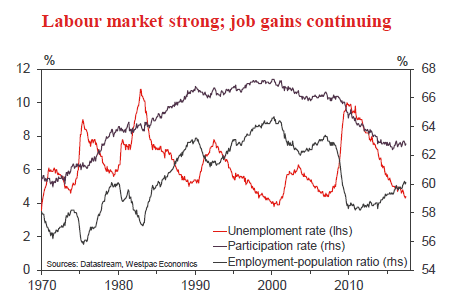Week beginning 31 July 2017
- RBA to keep rates on hold; retain upbeat growth forecasts.
- RBA: policy announcement, Statement on Monetary Policy.
- Australia: retail trade, dwelling approvals, trade balance, credit.
- China: Official & Caixin PMIs.
- NZ: employment.
- UK: BOE policy decision.
- Euro Area: CPI, employment.
- US: nonfarm payrolls, PCE inflation & personal spending.
- Key economic & financial forecasts.
Information contained in this report was current as at 28 July 2017.
RBA to keep rates on hold; retain upbeat growth forecasts
The Reserve Bank Board next meets on August 1.
Of course, the Board will keep rates on hold as clearly signalled by important speeches from both the Governor and Deputy Governor over the last week.
Therefore the interest directly associated with the Board meeting will be with the Governor’s associated Statement. No doubt the Governor will continue to "call out" the labour market and the housing markets as the key areas of interest. In that regard the sentiment in the July Board Minutes and the Governor’s July Statement is likely to be repeated.
On housing, "Conditions varied considerably across the country. Housing prices have been rising briskly in some markets, although there are some signs that these conditions are starting to ease …."
On the labour market, the commentary is likely to be along the lines of the Minutes, "Labour market conditions had improved … forward indicators had remained positive…….The strength of recent labour market data had removed some of the downside risk to the Bank’s forecast of wage growth."
However on that latter point the Governor’s speech on July 26 indicated that there was limited confidence in the call that wage rates would gradually increase over the course of the forecast period.
And then, of course, there is the Australian dollar. Since the last Board meeting the AUD has increased from USD 0.76 and a TWI of 65 to USD 0.795 and TWI of 67.
Even at USD0.76 the Governor repeated his consistent call that "an appreciating exchange rate would complicate this adjustment." The language is likely to strengthen at USD 0.795. In his speech on July 21 the Deputy Governor noted: "a lower AUD would be helpful."
In mid-2015, when the AUD was adjusting, the "path" from USD 0.80 to USD 0.75 was consistently associated with: "Further depreciation is likely/necessary."
It seems likely that the "commentary" on the AUD in the Governor’s Statement will be stronger than we have seen recently but we cannot be sure that a new "terminology" will be adopted.
Be clear that even though the move in the AUD is associated with higher commodity prices, the RBA is uncomfortable. The clear offset to services; manufacturing; and agricultural exports that we might expect from higher commodity prices is not materialising. Cashed up mining companies are not reinvesting and are not lifting employment in this cycle largely because they are not convinced of the sustainability of the current increases. As such the higher AUD is a "challenge" for both growth and inflation.
In that regard the second RBA report for the week will be more significant. The Statement on Monetary Policy will be released on August 4 and will contain the Bank’s revised growth and inflation forecasts.
These forecasts will be provided out to end calendar 2019, extending from June 2019 currently.
Recall the convention for the assumptions behind the forecasts. The rate profile is that indicated by market pricing and the AUD profile assumes the current level of the AUD.
When the last forecasts were released in May the rate outlook was flat while the AUD was at USD 0.74 and TWI 64.
Today markets are pricing in a 0.25% rate hike by the second half of 2018 while the AUD is likely to be assessed at USD0.80 or TWI 67.
The issue is whether the Bank will change its forecasts on the basis of the new "assumptions".
The key forecasts from a policy perspective are GDP growth in 2018 and underlying inflation in 2018 and 2019.
In May, GDP growth in December 2018 was forecast at 2.75%- 3.75% and underlying inflation at 1.5-2.5% in 2018 and 2-3% in June 2019.
We are not aware of the Bank’s specific modelling methodology and of course any potential "subjective" adjustments that might be applied to the modelling before the final results are released.
However we can assess some historical "form".
In November 2016, when AUD was at USD 0.77 and the TWI at 65, growth in 2018 was forecast at 3-4% and underlying inflation at 1.5-2.5%.
In May 2017, when AUD was at USD 0.74 and the TWI at 64, growth in 2018 was forecast at 2.75%-3.75% and underlying inflation at 1.5-2.5%.
You can see that between November and May there was a US 3 cents move in the AUD yet no significant changes were made in the forecasts. In fact a lower AUD was associated with a modest downward revision in the growth rate.
Elsewhere, the positive global back drop, with upgrades to world growth, and domestically the surprisingly strong employment figures, buoyant business confidence surveys and expansionary public investment would have boosted the Bank’s confidence in their above trend growth forecast for 2018 (with trend growth estimated at 2.75%). Those developments would support the Bank’s inclinations to keep their growth forecasts intact.
For 2019, consistent with the above, the RBA is likely to restate their 3.25% growth forecast for June 2019 and to also forecast 3.25% for December 2019, which rolls into the forecast horizon.
Certainly there seems little chance that the Bank would react to the AUD developments by lowering its underlying inflation forecast for 2018 which already sits at the bottom of the 2-3% target band.
No doubt there will be considerable angst at the Bank around the growth forecast.
For me, rigid adherence to the assumption of an AUD holding at USD0.80 over the next 3 years with a resulting change to the confident "above trend" growth story in 2018 would be an unattractive option for the Bank.
Consequently, despite the sharp short term move in the AUD, I expect the RBA to retain its "above trend" growth forecast when it releases its forecasts in the Statement on Monetary Policy on August 4.
Bill Evans, Chief Economist
Data wrap
Q2 CPI
- Headline CPI 0.2%qtr/1.9%yr. Trimmed mean 0.51%qtr/1.8%y. Weighted median 0.55qtr/1.8%yr
- The Q2 CPI printed 0.2% compared to Westpac’s forecast for 0.6%. The market median was 0.5%. The annual rate is now 1.9%yr compare to 2.1% in Q1, 1.5%yr in Q4, 1.3%yr in Q3 and 1.0%yr in Q2. The June quarter 2016 was the slowest pace since Q2 1999.
- The core measures, which are seasonally adjusted and exclude extreme moves, rose as expected at 0.5%qtr. In the quarter, the trimmed mean gained 0.51% while the weighted median lifted 0.55%, highlighting just how modest the broader inflation picture is outside of housing or health. The annual pace of the average of the core measures is now 1.8%yr flat on 1.8%yr in Q1, and up on 1.5%yr in Q4 and Q3.
- With the headline measure printing below market expectations (0.2% compared to 0.5%) why did the core measure rise as expected (0.5%)? It is all due to rent and dwelling purchases, which have a large weight and tend not to get trimmed out of the core measures. We argue that housing costs are important to factor in.
- The biggest surprise in the June quarter was the fall in fresh fruit & vegetable prices. The ABS does report something of cyclone Debbie boost in some fresh fruit and vegetables but this was offset by a seasonal fall in the price of winter fruits. This added to the known drag coming from falling auto fuel even if the fall in the quarter was not as large as we had anticipated.
- However, the more significant observation was the lack of price pressure in some major retail sectors and in particular, clothing & footwear. Normally clothing & footwear prices rise in the June quarter post the New Year sales in Q1 as prices are reset before the post June 30 sales in Q3. In the June quarter 2017, clothing & footwear fell 0.3%.
- Overall the June quarter CPI again highlighted the lack of any broad inflationary pressures in the Australian economy. While core inflation has drifted up to just under the bottom of the RBA’s target band, on the back on a lift in housing cost, it is hard to see how it can accelerate much further without broader price gains.
- There is some interest in the preliminary estimates for Q3 given the known significant increase in electricity bills. Our preliminary estimate is for a 0.8%qtr rise in the headline CPI and 0.3%qtr rise in the average of the core measures. This will hold the annual pace of the average of the core measures at 1.8%yr.
Q2 trade prices
- Australia’s terms of trade dipped in the June quarter 2017, representing a break from the recent rebound.
- Export prices for goods fell by 5.7% in the quarter, meeting expectations (market median -5.5% and Westpac -5.5%).
- Prior to this, in the year to March, export prices rebounded by almost 32%, up from the lows of early 2016. Annual growth has now moderated to 22.5%.
- Commodity prices eased back in the June quarter (on a quarter average basis), -10.6%. The falls were led by iron ore, impacted by rising inventories in China, and by coal.
- Import prices were little changed in the quarter, inching 0.1% lower, and also little changed relative to a year ago, edging 0.3% higher. The June result was softer than anticipated (market median 0.7% and Westpac 0.7%).
- The Australian dollar weakened in the June quarter, declining by 1% against the US dollar to 75.8¢ and falling by 2.2% on a TWI basis, to 64.5.
- While the lower dollar tends to make imports more expensive this was offset by falling global energy prices and general softness in world trade prices in the period.
- The terms of trade for goods rebounded sharply in the year to March 2017, up 30%. There was a partial reversal in the June quarter, down 5.6%, trimming annual growth to 19.3%.
- The rebound in commodity prices and the terms of trade during 2016 and into early 2017 boosted national income. Company profits, particularly in mining, jumped sharply. However there has been limited pass-through to households with wages growth still weak. The terms of trade pull-back in June 2017 will dent national income and company profits.
- Going forward, particularly during 2018, we expect commodity prices to trend lower, moving towards cost curves on softer demand and rising supply. However, in recent weeks, prices have been resilient, with spot iron ore up from US$55/t to US$70/t.
New Zealand: week ahead & data wrap
Old school
Next week’s labour market figures are expected to show that firms are still keen to hire, but that the unemployment rate has remained steady at 4.9%. Financial markets are probably more vulnerable to a softer than expected outcome, given the number of factors that already point to the Reserve Bank keeping interest rates on hold for a long time.
We expect the Household Labour Force Survey (HLFS) to show a 0.7% rise in employment over the June quarter. We also expect a similar result from the employer-focused Quarterly Employment Survey (QES), with a 0.9% rise in the number of full-time equivalent employees.
Growth in employment is expected to be widespread, with larger gains in service sectors (including hospitality), retail and professional services. We also expect continued employment gains in the construction sector, though difficulties in sourcing skilled labour may provide some brake on jobs growth on this front.
However, while the demand for workers is growing, the active labour force is also growing at a strong clip. The strong rise in population growth in recent years, led by trends in net migration, has been strongly motivated by job prospects. New arrivals have risen sharply, particularly for those coming on temporary work visas. At the same time, more New Zealanders are returning from Australia and fewer are leaving in the first place, which reflects the relatively subdued Australian jobs market in recent years.
As a result, we expect the unemployment rate to remain unchanged at 4.9%. That’s a marked improvement on the postfinancial crisis peak of 6.7%, but it’s not particularly low compared to history. The unemployment rate was consistently below 5% from 2003 to 2008, and it wasn’t until unemployment fell below 4% that the labour market tightened and wage growth really ramped up.
Consequently, with unemployment lingering around 5% now, we’ve yet to see a broad-based lift in wage growth in the current cycle – in fact, the Labour Cost Index for the private sector rose just 1.5% in the year to March, its slowest pace in seven years. While there are pockets such as the construction sector where a shortage of skilled workers is increasingly acting as a constraint, it doesn’t appear that the labour market as a whole has been in ‘tight’ territory up to now.
The idea of what constitutes ‘tight’ or ‘loose’ economic conditions was addressed in a speech this week by the Reserve Bank’s Head of Economics. The broad theme of the speech was that monetary policy decisions depend in part on judging where the economy stands relative to its long-run equilibrium settings, which are unobservable and can change over time.
One of those unobservable factors is potential output – the level of GDP that leaves inflation neither rising nor falling. Potential output is highly uncertain, and the RBNZ uses several estimation methods that produce a range of results. But the RBNZ’s central estimate suggests that the New Zealand economy has been running at around its potential for the last two years, having been below potential for several years after the financial crisis. In other words, it has not been in ‘tight’ territory – implying an acceleration in inflation – at any point in the last several years.
Another key unobservable that was covered in the speech is the neutral level of the Official Cash Rate (OCR). The RBNZ’s estimate of the neutral OCR has come down over time, and the latest estimate puts it at around 3.5%. That implies that the current OCR of 1.75% is providing stimulus to the economy, as is appropriate in the current circumstances.
However, lowering the estimate of the neutral rate implies that the current level of the OCR has not been providing as much stimulus as previously thought – and perhaps should have been set even lower in recent times. Of course, this is with the benefit of hindsight, but it suggests that the best way forward is to keep the OCR low for even longer.
As we’ve noted before, the RBNZ’s projections already imply that OCR hikes are a long way off. Our forecasts are not too dissimilar – we don’t expect a hike before 2019. In contrast, market pricing is still consistent with an OCR hike by August next year, and has at times implied an even earlier start to rate hikes.
We think that developments since the last OCR review will give the RBNZ even less reason to contemplate the idea of rate hikes. June quarter inflation was lower than expected, and some temporary factors are likely to keep inflation below the 2% target midpoint for at least another year. In addition, the housing market is slowing much faster than the RBNZ assumed, which is likely to have knock-on effects for the strength of domestic demand.
Finally, the New Zealand dollar has strengthened significantly in recent weeks. This is largely a product of US dollar weakness and may prove to be transitory. But if sustained, it will further undermine the outlook for inflation over the coming year.
Consequently, we think that financial markets are more vulnerable to a weak outturn in next week’s labour market update, which is one of the last key pieces of economic information ahead of the RBNZ’s Monetary Policy Statement on 10 August. Even a stronger than expected result is unlikely to see the RBNZ contemplate an OCR hike within the next year, whereas a weak result would see markets push out the expected timing of rate hikes.
Data previews
Aus Jun private credit
Jul 31, Last: 0.4%, WBC f/c: 0.4%
Mkt f/c: 0.4%, Range: 0.3% to 0.5%
- Private credit grew by 5.0% in the year to May, moderating from 6.4% a year earlier. Housing has slowed a little over this period, to 6.6% from 6.9%, as lending conditions have tightened. Business credit has moderated, to 3.1% from 7.0%, in part due to weakness around the time of the 2016 Federal election, as well as a soft start to 2017.
- For June, credit growth is expected to be 0.4%, matching the outcomes for the three months March through May.
- Housing credit grew by 0.55% in May, reversing a dip to 0.51% in April. The are tentative signs that the housing sector is beginning to cool, including a 1.5% decline in the total value of housing finance in the four months since January.
- Business credit grew by 0.4% in April and by 0.2% in May, representing a modest improvement on a 0.4% decline in Q1. Commercial finance, while still volatile, is up off its lows.
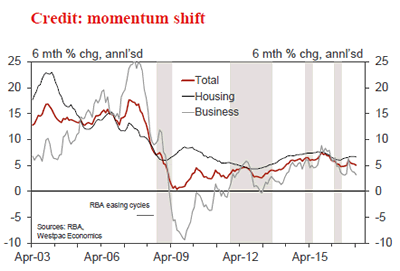
Aus RBA policy decision
Aug 1, Last: 1.50%, WBC f/c: 1.50%
Mkt f/c: 1.50%, Range: 1.50% to 1.50%
- The RBA will leave rates unchanged at its Aug meeting.
- Following two 25bp cuts in May and August 2016, the Bank has kept policy firmly on hold. Minutes to the July meeting reaffirmed labour and housing markets as particular areas of interest – key questions around both remain unresolved.
- A discussion of ‘neutral’ rates in the ‘Considerations for Policy’ section of the July minutes was seen by some as a more hawkish signal, contributing to a firming in the AUD.
- The RBA Governor has publicly rejected this view, reinforcing the Bank’s ‘firmly on hold’ stance. Despite this the AUD has continue to rise. How this is treated in the Governor’s decision statement and its forecasts in the Aug Statement on Monetary Policy (due Friday) will be of interest (see p2 for full discussion).
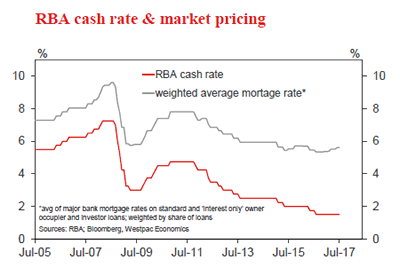
Aus Jun dwelling approvals
Aug 2, Last: -5.6%, WBC f/c: 1.0%
Mkt f/c: 1.0%, Range: -4.0% to 5.0%
- Dwelling approvals slumped 5.6% in May to be down 19.7%yr. The decline over both the month and the year has mainly been driven by ‘high rise’ (-20%mth, -45%yr). Nationally, May saw the second lowest monthly reading on high rise approvals since June 2013 – the lowest being the weatheraffected read in March.
- Despite the weak May update, June is shaping a little more positively. In particular construction-related finance approvals continue to suggest some firming in non-high rise activity in coming months. Meanwhile high rise approvals should start to stabilise around current lower levels although the outlook for this volatile segment is more uncertain. On balance we expect monthly total approvals to show a slight 1% gain leaving the existing strong downtrend intact.
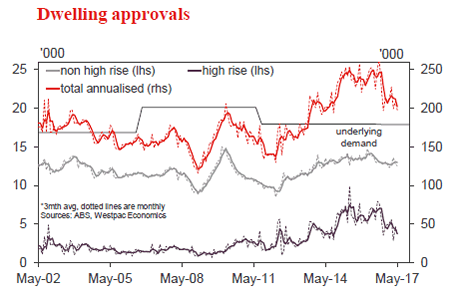
Aus Jun trade balance, AUDbn
Aug 3, Last: 2.5, WBC f/c: 1.4
Mkt f/c: 1.8, Range: 1.2 to 3.0
- Australia’s trade balance was comfortably in surplus in May, after being impacted by Cyclone Debbie in April.
- For June, we expect a $1.4bn surplus, narrowing from a $2.5bn surplus in May.
- Export earnings are forecast to decline by 4%, -$1.3bn. Metal ores, coal and fuels, together accounting for close to 50% of exports, are expected to weaken, down $1.4bn. Prices fell (iron ore and fuels), so too volumes (iron ore, coal and LNG).
- Imports are forecast to decline by 0.7%, $0.2bn, on lower prices, with oil down and the Australian dollar stronger.
- Note: since January 2016, there is additional uncertainty around the import and trade forecast. The ABS no longer publishes customs goods imports ahead of the trade release.
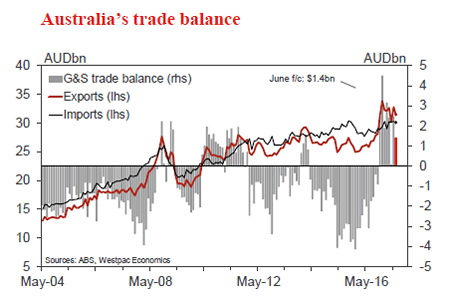
Aus Jun retail trade
Aug 4, Last: 0.6%, WBC f/c: flat
Mkt f/c: 0.2%, Range: -0.2% to 0.8%
- Retail sales came in better than expected for April with a 0.6% gain following on from April’s 1% bounce-back from a weather-affected 0.1% contraction in March. The April detail suggested a genuine lift in momentum over and above weather-related volume and price impacts.
- Despite the lift, the backdrop in terms of consumer sentiment remains shaky with signs family finances came under renewed pressure over the first half of 2017 with mortgage rate increases in March and continued concerns around housing markets. That said, labour market conditions have improved. The Q2 CPI also suggests retail prices have been flat with continued aggressive discounting in non-food segments. On balance we expect June to post a flat result for monthly sales.
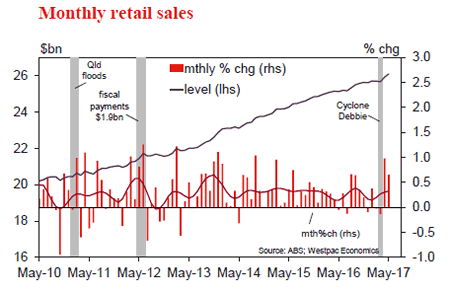
Aus Q2 real retail sales
Aug 4, Last: 0.1%, WBC f/c: 1.1%
Mkt f/c: 1.2%, Range: 0.6% to 1.5%
- Real retail sales rose just 0.1% in Q1 with weather a key restraining factor – sales in cyclone-affected Qld contracted 1%qtr but rose 0.4%qtr across the rest of Aus.
- The Q2 update is shaping as a strong one. Even with a flat monthly finish, nominal sales are on track for a 1.3% rise over the quarter. The CPI detail also points to a subdued retail deflator – up about 0.2% despite a weather-related jump in some food prices. The combination gives a 1.1% rise in real retail sales, with some upside risk if the deflator comes in weaker. Note that the retail measure remains a problematic indicator for the broader spending estimates in the national accounts – although the direction for Q2 looks right, the swings in total spending are likely to be much milder than the retail moves.
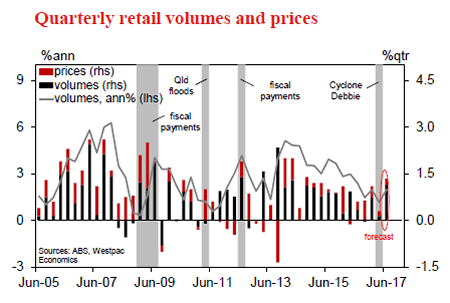
NZ June business confidence
Jul 31, Last: 24.8
- Businesses’ confidence in the general economic outlook rose strongly in June, with widespread gains.
- Since the June survey, we’ve seen mixed economic conditions. Spending has held up, boosted by the current strong tourist season. But at the same time, housing market conditions have continued to weaken (especially in Auckland). There is also some uncertainty around how September’s election will affect economic conditions.
- We’ll be watching the survey’s inflation and price gauges closely. Despite relatively firm economic growth in recent years, we’re yet to see a broad based increase in pricing pressures. We don’t expect much change on this front just yet.
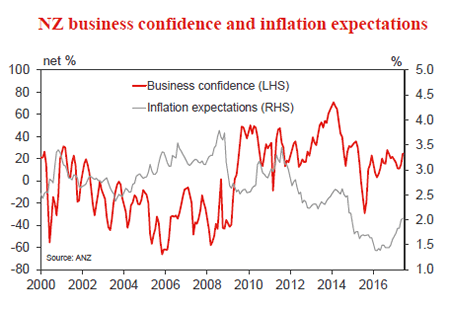
NZ June building consents
Jul 31, Last: 7.0%, WBC f/c: -5.0%
- Residential building consents rose 7% in May. That followed a 7.4% drop in April that looks like it was exacerbated by the timing of the Easter and Anzac Day holidays.
- After the solid May increase, we expect some pull back in consent issuance in June.
- Smoothing through month-to-month volatility, we should continue to see a trend increase in consents over the coming year, with large amounts of building work planned in coming years. However, there are questions around how fast construction will rise going forward. Capacity pressures in the building industry have already emerged, and both building costs and borrowing rates have been creeping higher. At the same time, house price growth has levelled off and reconstruction activity in Canterbury has eased back.
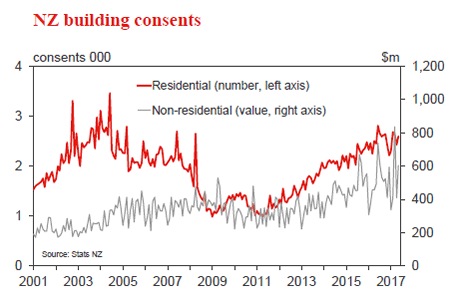
NZ Q2 household labour force survey
Aug 2, Employment, last: 1.2%, WBC f/c: 0.7%, Mkt f/c: +0.7%
Aug 2, Unemployment, last: 4.9%, WBC: 4.9%, Mkt f/c: 4.8%
- We expect the Household Labour Force Survey will show that employment levels increased by 0.7% in the June quarter. Increases in employment are expected to be widespread, with larger gains in service sectors (including hospitality), retail and professional services. We also expect continued employment gains in the construction sector, though difficulties sourcing skilled labour may slow jobs growth on this front.
- Labour force participation is expected to nudge higher again in June, taking it to a fresh record high of 70.7%. Jobs growth has encouraged more people to enter the labour market. This has been reinforced by strong net migration. These factors are providing a floor under the unemployment rate, which we expect to remain unchanged at 4.9%
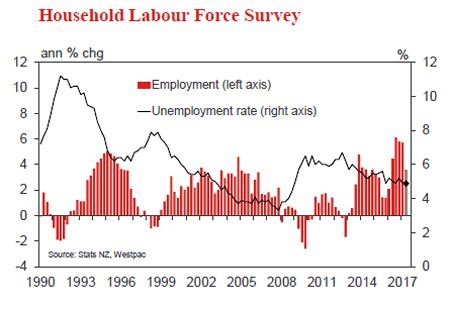
NZ Q2 labour cost index
Aug 2, Private sector (incl. overtime), last: 0.4%, WBC f/c: 0.4%, Mkt f/c: 0.4%
- Although the labour market has been strengthening, wage inflation remains low. We’re expecting the June quarter Labour Cost Index will show that base wage rates rose by only 1.6% over the past year. Similarly, the broader QES measures of average hourly earnings is expected to have risen by only 1.3% – both largely unchanged from last quarter and still low.
- But while wage growth is currently low, this won’t be the case forever. We expect that strong demand for workers, as well as increasing cost of living adjustments will contribute to rising wage inflation over the coming year.
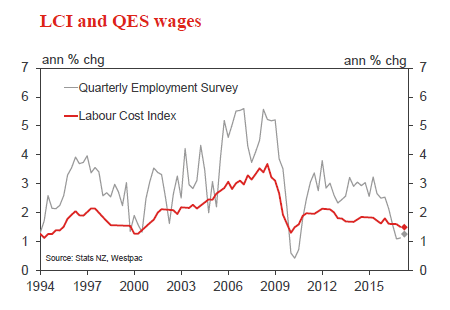
UK Mar Bank of England policy decision
Aug 3, Last: 0.25%, WBC f/c: 0.25%
- June saw a hawkish tilt from Bank of England. While the Bank Rate was left on hold, three of the eight members voted for an immediate rate hike in June, up from just one in May. Underlying this shift in stance was earlier firmness in economic activity that raised questions about how much of the recent pick-up in inflation should be looked through.
- Rate hikes are only a realistic possibility if there are convincing signs of resilience in economic activity. However, since the June meeting, inflation has softened and GDP growth has been subdued. We expect that these developments will see renewed caution among the MPC, with the Bank Rate and asset purchase program expected to remain unchanged in July.
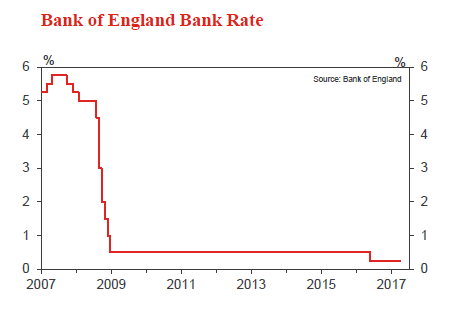
US Jul employment report
Aug 4, nonfarm payrolls Last: 222k, WBC 190k
Aug 4, unemployment report Last: 4.4%, WBC 4.4%
- It has been an interesting six months for employment growth in the US, nonfarm payrolls reporting month-average growth of 224k in Jan/Feb; a weak 50k in Mar; then 207k in Apr; 152k in May; and 222k in June. The net result is a month-average pace of 180k, broadly in line with 2016.
- At this stage in the economic cycle, given full employment has been reached, employment growth should have slowed. But it hasn’t and partial indicators remains supportive of further strong gains. In Jul, we look for a 190k rise.
- Since January, the unemployment rate has consequently fallen from 4.8% to 4.4% in June. Participation has also been a factor, edging 0.2ppts lower to 62.8%. In Jul, we expect the unemployment rate to remain unchanged, with any surprise in employment to be offset by participation.
